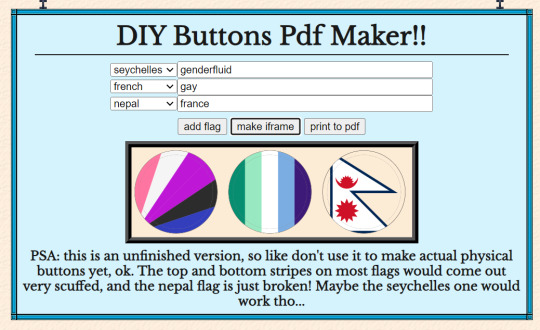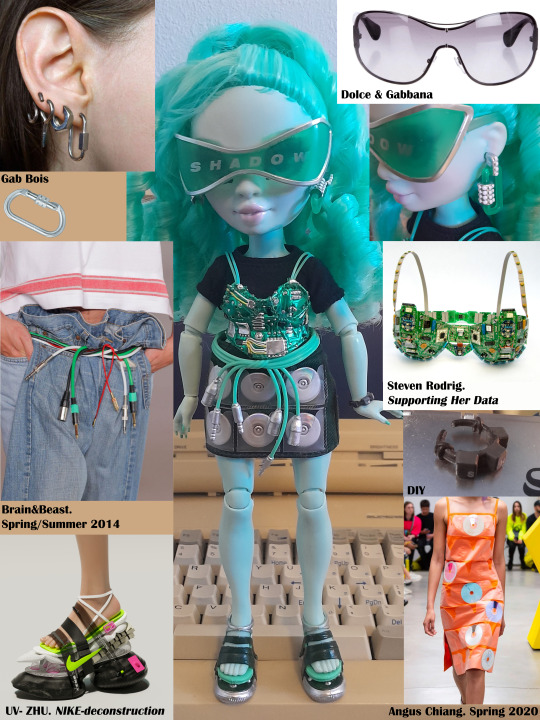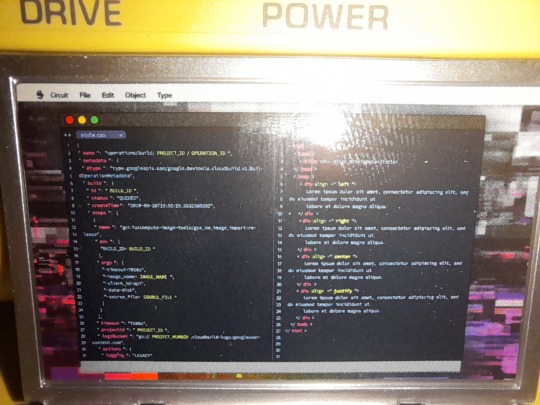#html diy
Explore tagged Tumblr posts
Text
So I took a break from using google products for a while. Last year I gave in and started using Jamboard. Fortunately since then I've picked up enough html to think I can clap together a tackboard for myself with plenty of space to make it pretty later. If I want to access it from just one computer, I can leave it in the file systems and run those internal files on a browsing program (life firefox) like any other .html website. If I want to be able to access it anywhere I'm logged into my home wifi, I can host it from a turned on device (a computer or a phone), or even maybe on a hard drive plugged into the router (some mid grade to fancy ones have usb ports for simple storage) It will be kind of clunky, but a fun project to improve the look and input options over time, and as long as I back up the files periodically, I don't have to worry about people out of town adding software migrations to my life. I think it's a reasonable goal to have more direct control over more of the computing tools I use, insofar as I can. I think a lot of accessibility has been taken off the internet and out of our cultural communication about how the 'net works... and with a little curiosity and flexibility, users can add that back for themselves perhaps.
#digital literacy#intro tech skills#solarpunk#power users#home LAN#html diy#geocities#neocities#retroweb#user control#host it yourself#don't get locked in appland
1 note
·
View note
Text

i made an upgrade to my flagmaker so it can be used to make templates for those DIY button making presses. it's hardcoded to use 50mm for now, but i want to add more options in the future. also need to fix the flags getting cut off my those circular margins
164 notes
·
View notes
Text
Building an RSS Feed for a Static Site
Lover's tree! Lover's tree! I have crafted an RSS feed for the first time! It was a pain in the ass, but I'm glad I learned how to do it.
This page was indispensable, but it doesn't have every part of what I learned, so I'll write my own tutorial below. Specifically, I used this with the Zonelets system, but it should work fine for most static sites.
First, make an .xml file. I just titled mine feed.xml and put it in the same directory as my blog.
Copy and paste the following into your xml file.
<?xml version="1.0" encoding="utf-8"?> <rss version="2.0" xmlns:atom="http://www.w3.org/2005/Atom"> <channel> </channel> </rss>
Between the <channel></channel> tags, we are going to do two things. First, we have to detail what our blog actually is.
<title>Title of your blog</title> <description>Description of your blog</description> <link>URL of blog</link> <atom:link href="URL of blog/feed.xml" rel="self" type="application/rss+xml" />
Change the stuff in pink to be what it's supposed to be.
Now, we are going to add a bunch of "items". Each item = a post in your blog. Copy and paste this template for each post:
<item> <title>Title of post</title> <link>link goes here</link> <guid>link goes here again</guid> <pubDate>Mon, 1 Jan 2023 00:00:00 EST</pubDate> <description><![CDATA[html of your post goes here]]></description> </item>
Change the stuff in pink to be what it's supposed to be. Keep to the structure as closely as possible, ESPECIALLY in the pubDate section. If you want to make sure your RSS feed works correctly, copy and paste the whole thing into the W3C Feed Validator and see if it gives you the OK.
Here is a (very condensed) version of what my RSS feed looks like, for comparison. The indents and colors are just for ease of viewing/understanding what every part is.
<?xml version="1.0" encoding="utf-8"?> <rss version="2.0" xmlns:atom="http://www.w3.org/2005/Atom"> <channel> <title>moonblog</title> <description>Please enjoy.</description> <link>http://moon-hotel.neocities.org/blog</link> <atom:link href="http://moon-hotel.neocities.org/blog/feed.xml" rel="self" type="application/rss+xml" /> <item> <title>Hello World</title> <link>https://moon-hotel.neocities.org/blog/posts/2023-06-24-Hello-World.html</link> <guid>https://moon-hotel.neocities.org/blog/posts/2023-06-24-Hello-World.html</guid> <pubDate>Sat, 24 Jun 2023 19:07:25 EST</pubDate> <description><![CDATA[<p>Hey, testing out <a href="http://zonelets.net">Zonelets</a> as a new blog engine. Hopefully it'll be easier--well, not easier, but more full-featured--than the way I was doing it? I really just wanted a way to do a blog on Neocities while also supporting stuff like Commento, so we'll see if that works.</p>]]></description> </item> </channel> </rss>
12 notes
·
View notes
Text
Okay, update from Mercury’s adventures in Casualty fandom history (staring at the internet archive and praying links work):
I really think the fandom was more active in the early 2000s, one day the main fan website got 1500 messages and while it was acknowledged as a lot for them, THAT’S A LOT. They had 200 members! Sadly, really, really, reallllly sadly, a lot of the stuff that would be most interesting to look at (the messageboard conversations and the fanfiction that got posted to the messageboards) hasn’t been archived. I’m trying to, like, console myself. Not to be all historian about medical drama fandom but it’s worth preserving and it’s a real shame to me that we appear to have lost parts of it.
I’ve been trying to tell myself “oh, I’m sure we didn’t lose anything too interesting!” (see: interesting to me… see: about the original paramedics) but I think I’m wrong about that because I’ve just found that someone was using the username ‘Ponting_Mute’ so you might say this is my Library of Alexandria.
2 notes
·
View notes
Text
If you want to create a website from scratch, check this site out!
0 notes
Text
HTML to WordPress Developer vs. DIY
Deciding between hiring an HTML to WordPress developer or taking the DIY route can impact your website's performance and customization. This article explores the benefits and challenges of each approach, helping you choose the best path. Discover how professionals at HireWPGeeks can streamline your conversion for lasting results.
#HTML to WordPress Developer#DIY WordPress#WordPress Development Services#HTML to WordPress#Website Conversion Guide#WordPress Customization
0 notes
Text
#Web development guide#Beginner web development#Web development tutorial#Website creation tips#HTML CSS JavaScript#Learning web development#Step-by-step web development#Web development basics#Building websites#Frontend development#Backend development#Web development resources#Web development for beginners#DIY web development#Web development skills
1 note
·
View note
Text
1 note
·
View note
Text
looking back at old phil videos and it’s so meaningful to me that he engages in fandom in a stereotypically “feminine” way. he had diy collages of sarah michelle gellar on his wall!!!! he wrote fanfiction!!!! there is no doubt in my mind he would have been handcrafting the html for his buffy tumblr blog if it existed at the time. he’s been one of us from day one
132 notes
·
View notes
Text
About diy critter clothes!
For those interested about the clothes patterns i use for my sylvanian families. I usually just look and print one from pinterest but here are the 2 i used recently.
this blog has a ton of diferent simple patterns that you can modify (including the one i use and abuse to make dresses for Anastacia): https://dinararabbit.livejournal.com/3145.html
this is the pinterest page (i couldn't find a source on it) of the adult critter hood i use: https://pin.it/2bJIGVGnr
But honestly, if you want a lot of free patterns, you can search for some simple ones on pinterest (hate that website tbh but some of these patterns do have a link to the source... still horrible website bc many just dont have a source :/)
There are also some cool youtube channels with tutorials:
Heebox
Maffy
MoonFlower (japanese but the visuals help a lot and they other diy)
And a lot more that im not familiar with and if you have another source feel free to reblog and add it! I'm interested too!
98 notes
·
View notes
Text
Ad | Some Humble Bundle Goodies
One for the audio engineers - The Audio Arcade bundle gives you a whole bunch of royalty-free music and SFX as well as plugins to insert in all the major game engines. Ambient tracks, environmental sounds, explosions, you name it.
Money raised goes towards Children's Miracle Network Hospitals.
For those who dabble in Virtual Reality, the Upload VR Showcase with Devolver Digital has a bunch of Serious Sam VR games as well as the Talos Principle, a really solid puzzle game.
Money raised goes to Special Effect which helps people with disabilities enjoy games via accessible controllers. I've seen the stuff they do and it's honestly great.
Want to get into programming but don't know where to start? The Learn to Program bundle has a tonne of resources covering everything from HTML and CSS through to Python, C# and Ruby.
Money raised goes towards Code.org which seeks to expand participation in computing science by helping women and students of colour.
The Future Tech Innovators Toolkit is a software bundle with courses on Robotics, Electronics and programming with Raspberry Pi and Arduino.
Money raised goes towards Alzheimers Research UK.
The Home How-To Guides bundle offers a complete set of books for home improvements and projects. Want to know more about plumbing, home repair, bathrooms, wiring or carpentry? This bundle has you covered.
Money raised goes to It Gets Better, a charity that supports LGBT Youth.
Want to pick up the latest Elden Ring DLC? It's also available on the Humble Store with the key being redeemable on Steam.
105 notes
·
View notes
Text
You like reading fanfics? How about reading about fanfics? 😏
Here’s what I've read so far (or am currently getting through) for my dissertation on fanfiction bookbinding! I'll be updating it as I go until the end of July. If you have any recs to add to the towering pile or any questions/opinions about something on there, I’m all ears!
on fan studies & ficbinding ✔
Alexander, Julia, ‘Making fanfiction beautiful enough for a bookshelf’, The Verge, 9 March 2021 <https://www.theverge.com/22311788/fanfiction-bookbinding-tiktok-diy-star-wars-harry-potter-twitter-fandom> [accessed 12 June 2024]
Buchsbaum, Shira Belén, ‘Binding fan fiction and reexamining book production models’, Transformative Works and Cultures, 37 (2022)
Dym, Brianna, and Casey Fiesler, ‘Ethical and privacy considerations for research using online fandom data’, Transformative Works and Cultures, 33 (2020)
Jenkins, Henry, Textual Pochers: Television Fans and Participatory Culture (New York: Routeledge, 1992)
Jenkins, Henry, ‘Transmedia Storytelling 101’, Pop Junctions, 21 March 2007 <http://henryjenkins.org/2007/03/transmedia_storytelling_101.html#sthash.gSETwxQX.dpuf> [accessed 12 June 2024]
Hellekson, Karen, ‘Making Use Of: The Gift, Commerce, and Fans’, Cinema Journal, 54, no. 3 (2015), 125–131
Kennedy, Kimberly, ‘Fan binding as a method of fan work preservation’, Transformative Works and Cultures, 37 (2022)
Minkel, Elizabeth, ‘Before “Fans,” There Were “Kranks,” “Longhairs,” and “Lions”: How Do Fandom Gain Their Names?’, Atlas Obscura, 30 May 2024 <https://www.atlasobscura.com/articles/fandom-names> [accessed 12 June 2024]
Penley, Constance, Nasa / Trek: Popular Science and Sex in America (London: Verso, 1997)
Price, Ludi, ‘Fanfiction, Self-Publishing, and the Materiality of the Book: A Fan Writer’s Autoethnography’, Humanities, 11, no. 100 (2022), 1–20
Schiller, Melanie, ‘Transmedia Storytelling: New Practices and Audiences’, in Stories: Screen Narrative in the Digital Era, ed. by Ian Christie and Annie van den Oever (Amsterdam: Amsterdam University Press, 2018), 99–107
on folklore, the internet, other background reading ✔
Barthes, Roland, ‘La mort de l’auteur’ in Le Bruissement de la langue: Essais critiques IV (Paris: Éditions du Seuil, 1984)
Blank, Trevor J., Folklore and the Internet: Vernacular Expression in a Digital World (Logan, Utah: Utah State University Press, 2009)
Mauss, Marcel, ‘Essai sur le don. Forme et raison de l’échange dans les sociétés archaïques.’, L’année sociologique, 1923–1924; digital edition by Jean-Marie Tremblay, Les classiques des sciences sociales, 17 February 2002, <http://classiques.uqac.ca/classiques/mauss_marcel/socio_et_anthropo/2_essai_sur_le_don/essai_sur_le_don.html> [accessed 10 June 2024]
McCulloch, Gretchen, Because Internet: Understanding How Language is Changing (Random House, 2019)
Niles, John D., Homo Narrans: The Poetics and Anthropology of Oral Literature (University of Pennsylvania Press: Philadelphia, 1999)
hopefully coming up next (haven't started yet)
A Companion to Media Fandom and Fan Studies, ed. by Paul Booth (Hoboken: John Wiley & Sons, Inc., 2018)
A Fan Studies Primer: Method, Research, Ethics, ed. by Paul Booth and Rebecca Williams (Iowa City: University of Iowa Press, 2021)
Dietz, Laura, ‘Showing the scars: A short case study of de-enhancement of hypertext works for circulation via fan binding or Kindle Direct Publishing’, 34th ACM Conference on Hypertext and Social Media (HT ‘23), September 4–8, 2023, Rome Italy (ACM: New York, 2023)
Fathallah, Judith May, Fanfiction and the Author: How Fanfic Changes Popular Cultural Texts (Amsterdam: Amsterdam University Press, 2017)
Finn, Kavita Mudan, and Jessica McCall, ‘Exit, pursued by a fan: Shakespeare, Fandom, and the Lure of the Alternate Universe’, Critical Survey, 28, no. 2 (2016), 27–38
Hjorth, Larissa et al., eds. The Routledge Companion to Digital Ethnography (New York: Routledge Taylor & Francis Group, 2017)
Jacobs, Naomi, and JSA Lowe, ‘The Design of Printed Fanfiction: A Case Study of Down to Agincourt Fanbinding’, Proceedings from the Document Academy, 9, issue 1, article 5
Jenkins, Henry, Convergence Culture: Where Old and New Media Collide (New York: New York University Press, 2006)
Jenkins, Henry, Spreadable Media: Creating Value and Meaning In A Networked Culture (New York: New York University Press, 2013)
Kennedy, Kimberly, and Shira Buchsbaum, ‘Reframing Monetization: Compensatory Practices and Generating a Hybrid Economy in Fanbinding Commissions’, Humanities, 11, no. 67 (2022), 1–18
Kirby, Abby, ‘Examining Collaborative Fanfiction: New Practices in Hyperdiegesis and Poaching’, Humanities, 11, no. 87 (2002), 1–9
Kustritz, Anne, Identity, Community, and Sexuality in Slash Fan Fiction (New Work: Routeledge, 2024)
Lamerichs, Nicolle, Productive Fandom: Intermediality and Affecive Reception in Fan Cultures, (Amsterdam: Amsterdam Universtiy Press, 2018)
Popova, Milena, ‘Follow the trope: A digital (auto)ethnography for fan studies’, Transformative Works and Cultures, 33 (2020)
Rosenblatt, Betsy, and Rebecca Tushnet, ‘Transformative Works: Young Women’s Voices on Fandom and Fair Use’, in eGirls, eCitizens: Putting Technology, Theory and Policy into Dialogue with Girls’ and Young Women’s Voices, ed. by Jane Bailey and Valerie Steeves
Soller, Bettina, ‘Filing off the Serial Numbers: Fanfiction and its Adaptation to the Book Market’, in Adaptation in the Age of Media Convergence, ed. by Johannes Fehrle, Werner Schäfke-Zell (Amsterdam: Amsterdam University Press, 2019), 58–85
#fanbinding dissertation#fanbinding lit#bibliography#dissertation#reading list#gradblr#study blog#research#fanfiction#bookbinding#fanbinding#ficbinding#fanfic#ethnology#folklore#currently reading
50 notes
·
View notes
Text



I got Berrie Skies' doll the other day and have been researching her for a few days. There's some things others have already pointed out like the Angus Chiang inspiration behind her CD-skirt and the Brain&Beast aux cable belt. Her bracelet is like a DIY project using recycled key caps and wire. I believe her earrings, which look like screw carabiners, are inspired by Gab Bois. They aren't computer-y but they do fall in line with her theme of recycling hardware. Her shoes are from UV-ZHU's NIKE-deconstruction series, again with a recycling theme. I couldn't find anything that exactly matched her circuit top but I do like Steven Rodrig's piece, Supporting Her Data. I also couldn't find an exact match for her glasses, just a lot of results for y2k shield sunglasses.
Her color theme reminds me of the iMac color Bondi blue, I wish she was a little closer to that color. There was also a line of fruit colored iMacs, including a blueberry color.
On her laptop, Berrie is editing HTML and CSS files which are what websites are made of. CSS files usually define the style of webpages but this file is showing info about google cloud API. I'm not sure if that's supposed to go in a CSS file as I only know how to write basic CSS. The HTML file looks like example code for how the "div align" element works. She might be the designer/programmer for RH's site or the Daily Shadow's website?
Regarding her name, I like the comparisons to the Raspberry Pi, so I've been calling her Berrie Pi :)
129 notes
·
View notes
Text
DIY Patient Monitor
It's been a while since I posted! In the last post I presented my DIY wireless ECG. Today, I want to follow up on that post. In the last two years I added more and more consumer medical devices and features to the ECG that one might call it a DIY patient monitor 😀
I recorded myself using it in this video. I deprived myself of oxygen and watched the result on the monitor. See all the alarms going off 🙂
The design is inspired by Philips Intellivue. The alarm sounds I took from their website 😉
In the rest of this post I want to discuss how I came to this result.
Devices
The DIY ECG from last post was a good basis (https://www.tumblr.com/medical89/650543279114469376/diy-wireless-ecg?source=share).
I got a BP with bluetooth capabilities (https://www.medisana.com/en/Health-control/Blood-pressure-monitor/BU-540-connect-Upper-arm-blood-pressure-monitor.html)

And a pulseoximeter with bluetooth (https://de.aliexpress.com/item/1005005549153646.html)

I reverse engineered (aka hacked) both of their bluethooth communication to get the live data into my website instead of their apps. I.e., get the BP after it was measured or retrieve the oxygen concentration every second. Then I extended my ECG application and it's web interface to include this information.
Alarms
The application now also includes alarms, just like a real patient monitor. Cyan alarms are triggered if a device is not connected correctly, red alarms if a vital value is outside of its limits!
Buttons
I also wired up the power button on the BP to my ECG so I can start it from the website using the BP button. When entering a number in the text field next to the button, the BP is taken automatically every x seconds 🙂
The shock button is wired up to a TENS unit and can give shocks.
I also made a program that can sync shocks and BP inflates to a video, but that's a story for another day!
Hope this was interesting for you and feel free to contact me to ask for more details 🙂
23 notes
·
View notes
Text
How to Do Web Development
Introduction to Web Development
Web development is the process of creating websites or web applications that are accessible over the internet. In today's digital age, having a strong online presence is crucial for businesses and individuals alike. Whether you're building a personal blog, an e-commerce platform, or a corporate website, understanding the fundamentals of web development is essential.
Understanding the Basics
HTML: The Backbone of Web Development
HTML, or Hypertext Markup Language, is the standard markup language used to create the structure of web pages. It provides the basic building blocks for organizing content on the web. With HTML, you can define headings, paragraphs, lists, images, and other elements that make up a webpage.
CSS: Adding Style to Your Website
CSS, or Cascading Style Sheets, is used to enhance the presentation of HTML elements. It allows you to control the layout, colors, fonts, and other visual aspects of your website. CSS enables you to create responsive designs that adapt to different screen sizes and devices.
JavaScript: Making Your Website Interactive
JavaScript is a programming language that adds interactivity and dynamic behavior to web pages. With JavaScript, you can create interactive forms, animations, and user-friendly interfaces. It is widely used in frontend development to enhance the user experience.
Choosing the Right Tools and Technologies
Before starting a web development project, it's essential to choose the right tools and technologies based on your requirements and preferences.
Frontend Frameworks
Frontend frameworks like React, Angular, and Vue.js provide pre-built components and libraries to streamline the development process. They offer features like state management, routing, and data binding, making it easier to build complex web applications.
Backend Technologies
For server-side development, you can choose from a variety of backend technologies such as Node.js, Ruby on Rails, Django, and Laravel. These frameworks provide tools for handling database operations, authentication, and server-side logic.
Planning Your Web Development Project
Defining Goals and Objectives
Before diving into development, it's essential to define clear goals and objectives for your website. Whether it's increasing brand awareness, driving sales, or providing valuable content, having a clear vision will guide the development process.
Creating a Wireframe and Mockup
A wireframe is a visual representation of the layout and structure of your website. It outlines the placement of content, navigation elements, and user interface components. Mockups, on the other hand, provide a more detailed visual design, including colors, typography, and imagery.
Writing Clean and Maintainable Code
Importance of Clean Code
Writing clean and maintainable code is essential for the long-term success of your web development project. Clean code is easy to understand, modify, and debug, reducing the likelihood of errors and technical debt.
Best Practices for Writing Maintainable Code
Follow coding standards and best practices to ensure consistency and readability in your codebase. Use meaningful variable names, comment your code, and modularize your code into reusable components or functions.
Testing Your Website
Importance of Testing
Testing is a critical part of the web development process to ensure that your website functions correctly and meets the intended requirements. It helps identify bugs, performance issues, and compatibility issues across different browsers and devices.
Types of Testing in Web Development
There are various types of testing in web development, including unit testing, integration testing, regression testing, and usability testing. Each type serves a specific purpose in validating different aspects of your website.
Launching Your Website
Deployment Process
Once your website is developed and tested, it's time to deploy it to a web server and make it accessible to the public. The deployment process involves configuring the server, uploading files, and configuring domain settings.
Post-Launch Considerations
After launching your website, it's essential to monitor its performance, security, and user feedback continuously. Regular updates and maintenance are necessary to keep your website running smoothly and securely.
Continuous Learning and Improvement
Keeping Up with Industry Trends
Web development is a constantly evolving field, with new technologies and trends emerging regularly. Stay updated with industry news, attend conferences, and participate in online communities to keep abreast of the latest developments.
Expanding Your Skillset
To stay competitive in the job market, continuously expand your skillset by learning new programming languages, frameworks, and tools. Invest in online courses, tutorials, and hands-on projects to enhance your expertise in web development.
Web development is an exciting and dynamic field that offers endless opportunities for creativity and innovation. By mastering the fundamentals, choosing the right tools, and adopting best practices, you can build high-quality websites that engage users and achieve your objectives. Click Here
#Web development guide#Beginner web development#Web development tutorial#Website creation tips#HTML CSS JavaScript#Learning web development#Step-by-step web development#Web development basics#Building websites#Frontend development#Backend development#Web development resources#Web development for beginners#DIY web development#Web development skills
0 notes
Text
in-depth DIY instructions on html pages written in the mid 2000s i love you <3
2 notes
·
View notes